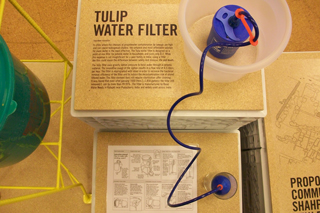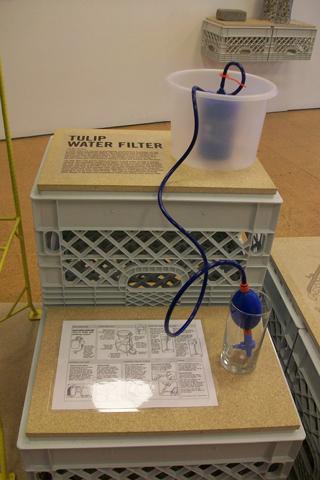Human Flower Project
From the Lowlands, a ‘Floral’-Filter
The Local Ecologist spots a new water filtering tool. It works well to extract E coli? What about radioactivity?

A new point-of-use water-filtering device
Photo: Georgia Silvera Seamans/Local Ecology
By Georgia Silvera Seamans
Holland is known for its flower industry and its water technology. The country supplies “60% of the world’s flowers.” And “one quarter of Holland is below sea level”; according to the website waterland, “Two thirds of [the country] would be flooded if there were no dikes,” but by the second half of the twentieth-century, Holland had “gained a reputation as a country that had won the war against water.”
 Would the Tulip remove radioactive elements?
Would the Tulip remove radioactive elements?
Photo: Georgia Silvera Seamans/Local Ecology
The founding of Basic Water Needs there, in Holland, must account for the name of the company’s water filter – the Tulip.
I saw the filter at the AIA New York Center for Architecture gallery; it is part of the gallery’s Jugaad Urbanism: Resourceful Strategies for Indian Cities exhibit. The filter is manufactured in Pondicherry in Tamil Nadu, South India, by Basic Water Needs India.
The filter is described as a “point-of-use” filter providing potable water at a cost of $12 ($12 US = 537.384 Indian rupees). Water is forced by gravity siphon-pressure through ceramic material which has been “impregnated with silver.” Silver reduces bacterial contamination during filtration and deters contamination if filtered water is stored in the filter. The filter can clean four to five liters of water per hour. The Tulip has been found to remove 99.99% of E. coli after filtering 7,000 liters or approximately 1,850 gallons of water.
 It is not surprising that a Dutch company would tackle the problem of cleaning drinking water, though the Tulip filter was actually developed to purify groundwater contaminated by sewage in India and other developing countries. Water Information Network, based in Holland, lists nitrate (manure-contaminated groundwater) and fertilizer pollution as the biggest challenge to delivering potable water to households in the Netherlands.
It is not surprising that a Dutch company would tackle the problem of cleaning drinking water, though the Tulip filter was actually developed to purify groundwater contaminated by sewage in India and other developing countries. Water Information Network, based in Holland, lists nitrate (manure-contaminated groundwater) and fertilizer pollution as the biggest challenge to delivering potable water to households in the Netherlands.
Actually, naming the filter after the tulip might have been more than a nationalistic decision. Tulips will bloom in the winter if they are placed in water. And, while I did not think the filter looked like a tulip when I saw it at the AIA gallery, it does bear some resemblance to a vase with tulip bulb being forced into flower.

